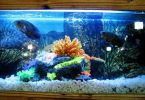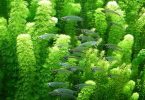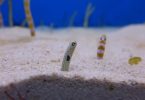Table of Contents
What are bottom feeders?
Bottom feeder fish is the aquatic animal that primarily lives and eats at the bottom of a water on or near the body of water.
Instead of grabbing food on its surface, or the middle, the bottom feeders get their food from the substrate or at the bottom of the water. Some are scavengers who usually eat dead invertebrates and fishes.
What Classifies Bottom Feeder Fish?
If you’re wondering what characteristics a bottom feeder fish has, this section will help you figure it out.
While “fish that spend most of their time at the bottom of the tank” is the short answer, there are a few other characteristics that will likely stand out more.
-
Type of mouth and their position
Fish that eat at the bottom of the food chain typically have a very unique mouth structure. This facilitates grabbing and eating as they move along the substrate.
Bottom feeders’ fish, oftentimes utilized in various contexts, are characterized by the presence of suckermouths.
The first is to assist them in remaining in the area where they are camped. In your tank, this could be a rock, a log, or a glass.
When it comes to food, it’s just as efficient. The suckermouths of these fish help them break free of any sticky situation, which is useful given that they eat algae and other microscopic organisms that can be difficult to get to.
The fish’s mouths are located on its underbelly. Considering how they forage and scavenge for sustenance. This enables them to swiftly seize prey from the substrate while keeping an eye out for danger.
-
Flattened Bellies
Bottom-feeding fish benefit greatly from a flat stomach because they frequently roll over the bottom or rest on flat surfaces.
Other fish have to swim down to the ground and make a full body pivot to search for food that has fallen to the floor.
Bottom-dwellers who have flat bellies find it easier to stay close to the substrate so they won’t miss anything and can quickly grab food that falls on the ground.
-
Barbels
Barbels are little like slender whiskers located on the head of a fish which may also extend from the nostrils or can sometimes be on the chin. They are used as aid to navigate successfully in low visibility bodies of waters or murky waters in search of food.
Barbels also hoses taste receptors that distinguish between enzymes in water and also to know if it is food or a possible source of danger.
Benefits of bottom feeder fish for your fish tank.
The bottom feeders feed on leftovers that sink in-depth, they also feed on dead matter to algae in the bottom of the tank.
They eat pieces of food that make it past top and mid-levels of the aquarium. More so, the aquariums are likened to small ecosystems, and they work in the same way as ponds and lakes.
This keeps the aquarium clean while maintaining balance in the ecosystem. In the absence of the bottom scavengers or feeders, leftovers will decay and the aquarium will get contaminated.
Also, including bottom feeders in your aquarium tank will another layer of interest that will make your aquarium look good and nicer?
They come in many shapes and colors. And each species has its own behaviors.
The bottom layer of the tank can be made colorful and pleasing not only by pebbles, plants, and crustaceans.
It is also essential to add bottom dwellers to your tank as they can add delightful movements to the lower end of the tank.
Listed below are fourteen bottom feeder fishes:
1. Bristlenose Pleco
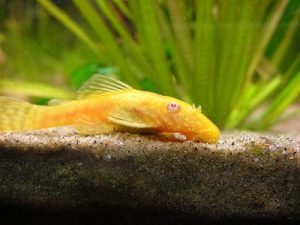
“Albino bristlenose pleco” by novocainstain is licensed under CC BY-NC-ND 2.0
This is one of the smallest aquarium species that exist. It is widely sought after for its small size, compactness and easy-going nature.
Similar to the suckermouth Pleco, Bristlenose pleco also continues to absorb algae and other particles from the tank, thus cleaning the tank.
They come in dark, subtle and pale colors such as black, brown, gray, olive and albino and are easy to care for as they are calm. They live up to five years and can grow up to 5 inches in size.
Bristlenose plecos have tentacles on their head and bony plates covering their bodies. The tentacles of the male fish are longer compared to the female.
They are constantly sucking and sweeping the bottom of the tank. As easy to maintain, it is a good choice for beginner’s fish keepers.
2. Carp
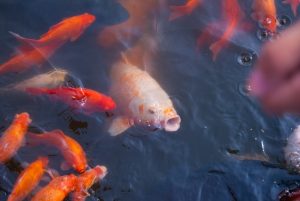
The species of carp are mostly in the water of North America from Europe and Asia. Even though the carp, the most green fish, sometimes feeds on the bottom. They are omnivorous and so feed on plants, larvae, algae, and bugs on land.
They equally inhabit lakes, streams, and rivers. The common carp crawls on the ground and uses its ventral mouth to catch anything that is edible. More so, its teeth are found in its throat and looks like the molars of humans.
3. Peppered Cory catfish

These feeders on the bottom have green and black spots around the body, and under its parts are white in colour. This species is not difficult to be cared for, and is recommended to beginners.
They are amazing and you can have a lot of fun watching them being in a group of about six or more in a tank.
The Peppered Cory catfish need nutritious food, so they need food for both animal and plant, and it is okay to feed them dipped fish, dried worms, shrimp pellets, and other foods that are organic.
They equally need at least a tank of about ten water gallons, with enough and proper hiding places like the coconut caves, in which they can hide away from light.
4. Loaches
There are many varieties of loaches suitable for aquariums and good for aquarists with great experience, and hence there are about three types of loaches recommended for beginners.
5. Zebra Loach

This is an amazing species of the loach, they are bottom dwellers and grow up to similar length as other common fish, for about three point five over nine centimeters and are perfect for aquariums.
Just like its name, it has a white and black colour, and its tail and fins are translucent.
Feeding the loach is not very tasking as it can feed on a daphnia, catfish pellets, and brine shrimp. They are best kept in a seventy-eight liter tank, with substrates that are quite soft.
6. Kuhli loach
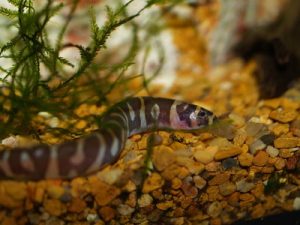
“Kuhli Loach” by Kasia/flickr is licensed under CC BY-ND 2.0
They are usually about thirteen inches in size, and can live until about fourteen years under the right water conditions.
They are friendly and interact with other species, and although they are bottom feeders, the khuli loach swim separately, hence, it is commendable to have about five of them in one tank that is about eighty centimeters by its size.
In appearance, the fish has an eel shape, and is yellow with brown and black stripes that are vertical. They also have some barbels within their mouth, this barbel helps them feel the food within a range.
They are carnivores and can hunt for their food, and can still be served with frozen foods or foods such as bloodworms and the brine shrimp. They are not friendly with shrimps and snails and should not be added together.
7. Yoyo Loach (Botia almorhae)
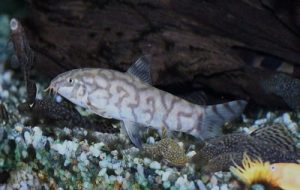
“Yoyo Loach” by Ken_Lord is licensed under CC BY-NC-SA 2.0
The yoyo loach grows to about 13-15 cm in size. This species is usually active and need a substrate and the depth of a tank for food.
However, because of the energy they emit, fishes that are smaller in size and are not very active tend to stay away from them.
This species have black and brown stripes around its body from which the name yoyo was derived because the stripes that are black in colour are Y as in shape and are across the O on its body, hence the name yoyo.
They are also carnivores and will feed on pellets and fish flakes, so aquarists must be careful before adding any little invertebrate.
8. Otocinclus sp.

“File:Otocinclus Catfish (Otocinclus sp.) on Malaysian driftwood.jpg” by Evan Baldonado is licensed under CC BY-SA 4.0
Otocinclus species usually do well with in groups of at least 6 per tank. This species have a peppered body with black colour, they have about ten centimeters.
They are peaceful, friendly and are able to be with small fishes. However, they have a different diet which is why it is not easy to care for them. This species feeds on Algae wafers and vegetables as vegetarians.
They feed on algaes so much that they start to clean up stones to ensure that there are no more algaes on the glasses, in the caves, and other hiding places, as well as in different parts of the aquarium, because of their sizes, a tank size of about thrirty-eight liters (38 liter) with enough small caves, and rocks for their hiding places is eassential.
They need a good substrate, a good aeration, and a standard system of filtration.
9. Twig catfish (Farlowella sp.)
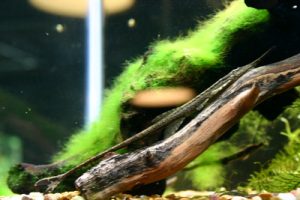
“Twig Catfish” by Ryan Somma is licensed under CC BY-SA 2.0
The Farlowella or the twig species of catfish is part of the bottom feeders, and grows up to fifteen centimeters in size.
This species of fishes has a unique ability to hide in its natural habitats because of its appearance, which has also giving it its name.
In appearance, the fish is slender, long, and beautiful with an elongated nose, as well as a beautiful brown and black colour, and most importantly, a twig like look that gives it the name. They are very beautiful, and add the best to most tanks.
They feed on plants and animals and so are omnivores. It is best to feed them frozen food, blood worms, and algae.
More so, twigs get nutrients from algae and fishes that are left over, however, it is important to monitor their feeding routine to be sure that they eat healthy.
Twigs require a tank that is about fifty gallons, and the tank must have enough pebbles and rocks.
10. Bumblebee goby
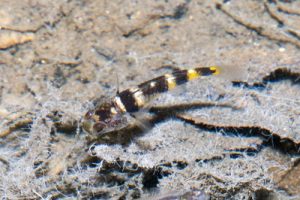
“Mangrove bumblebee goby (Brachygobius kabiliensis)” by wildsingapore is licensed under CC BY-NC-SA 2.0
The Bumblebee Goby is native to freshwater areas in the southeastern part of the Asian continent. These carnivorous fish seem to sweep the bottom of the tank into which they are allowed to enter.
The Bumblebee Gobies grow to a height of 4.2 inches. They have a short life span of four years.
They are always sought for their sophisticated appearance and their colorful presence. Bumblebee loaches are very knowledgeable about their location, so they may be able to fight off areas more often.
The scientific name of Bumblebee Goby is Brachygobiusxanthozona. it requires the supply of very brackish water to thrive. So be careful when buying a Bumblebee Goby for your aquarium or tank.
11. Siamese Algae Eater
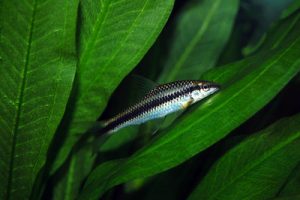
“Siamese Algae Eater” by carolineCCB is licensed under CC BY 2.0
The eaters of Siamese algae are silver or gold in color with a black horizontal line separating their body. Their smooth body makes them look attractive.
As the name implies, these fish are award-winning winners in the field of algae food. If you are going to buy them and put them in your tank, then you do not have to worry about cleaning up the annoying algae waste. People often confuse the Siamese flying fox with the Siamese Algae Eater.
The scientific binomial of Siamese Algae eaters is Crossochelius oblongus. These are the most peaceful fish that grow well on their own and in groups.
These fish are also very easy to care for as they require very little attention. They live for up to ten years and grow to a size of six inches.
12. Tiger Shovelnose Catfish
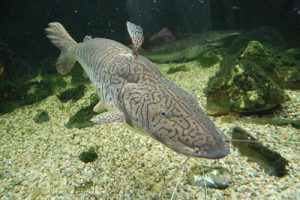
“Tiger Shovelnose Catfish” by scary_mary is licensed under CC BY-NC-ND 2.0
The scientific binomial of Tiger Shovelnose Catfish is the Pseudoplatystomafasciatum. The common name for this fish is Barred Sorubium.
These are many types of fish, so be prepared to buy a larger tank. They will grow to over 60 pounds in size.
They are very east to take care of. The only thing that matters is that you have to give them more space. They reach a height of 15 feet 4 feet and can live up to 20 years in ideal conditions.
13. Snails

Aquatic snails are among the most effective bottom feeders. They excel at searching in inaccessible areas of algae.
The snail has an advantage over other algae-eating fish because of its tenacity and diminutive size. And they require about as little upkeep as anything else out there. The maintenance required is minimal.
14. Shrimp
Shrimp, despite being one of the most underappreciated bottom feeders, can do wonders for the cleanliness and orderliness of your aquarium even when their numbers are low.
These little critters will regularly patrol your freshwater aquarium, searching for algae and other floating organisms, much like snails. I love watching these cute little creatures.
Many aquarists miss out on the joys of shrimp by hastily stocking their tanks with fish. They can be easily maintained and are compatible with many other fish species.
As long as the freshwater conditions required are the same as the shrimp it will be fine. There are a plethora of high-quality shrimp available for your aquarium.
The Cherry shrimp and amano shrimp are among our absolute favorites. You can have the best of both worlds with either of these animals.
Conclusion
There is a wide variety of large, suitable bottom feeder fish available now that you can add to your aquarium. It doesn’t matter what kind of fish tank you have.
No matter what type of setup of fish tank you have. Water should be conditioned and filtered the right way.
The filter of ammonia and nitrate should be kept low. These fish are very sensitive to sudden changes; you have to keep an eye on them.



